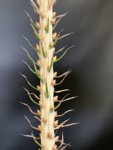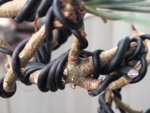markyscott
Imperial Masterpiece
So I think we’re all at least familiar with the growth patterns of Japanese Black PIne. After the spring growth, terminal bud development continues through the summer and is wrapped up by fall. The base of the terminal bud is the seasonal node. Internodal elongation of the winter bud takes place in the following spring and essentially all of the activity is below the shoot apical meristem. The elongation itself produces a long candle consisting of a basal portion devoid of needles called the “neck” and a upper portion in which the needles will extend from their sheath. The shoot apical meristem itself will remain pretty much inactive until sometime in the period of elongation, when it starts forming the next bud. You can see the parts of the shoot on the extending candles of this Eastern White Pine.

I’m used to adventitious buds forming one of two places - either at one of the the seasonal nodes OR at the base of a needle pair. The latter are sometimes referred to as needle buds to distinguish them from buds forming at the nodes.
You can see both types of adventitious buds in this picture by Eric Schrader - the axial buds forming at the node and the needle buds forming at the base of a needle pair.


I’m used to adventitious buds forming one of two places - either at one of the the seasonal nodes OR at the base of a needle pair. The latter are sometimes referred to as needle buds to distinguish them from buds forming at the nodes.
You can see both types of adventitious buds in this picture by Eric Schrader - the axial buds forming at the node and the needle buds forming at the base of a needle pair.

Last edited:








